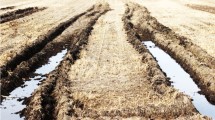Abstract
The claim has often been made that nanotechnologies will contribute to the global development process. In 2005, a careful study identified specific areas where nanotechnologies could help developing countries achieve the millennium development goals. This article examines whether the research agenda of nanotechnology in the intervening period, as reflected in publications, has followed the directions identified at that time, in three key areas, water, energy, and agri-food. We find that the research community has taken up the broad directions indicated in the earlier study, although not so often the detailed applications of specific nanoscale techniques or phenomena. However, the impact on global development is unclear, both because the same applications can be useful in both developed and developing countries, and because the conditions in developing countries may not match the socio-technical requirements of the applications.









Similar content being viewed by others
Notes
Because of the heterogeneity among the so-called “developing countries,” we avoid lumping them into one category and instead refer either to low and middle income countries (referring to World Bank measures of national income per capita), or later in the article to their status on the human development index. The phrase developing country will therefore appear in this article only when it was used by the original author(s), and then it will appear in quotation marks. We will refer to the World Bank category of high income countries as affluent.
http://www.un.org/millenniumgoals, accessed December 30, 2011.
The US National Nanotechnology Initiative defines nanotechnology as “the understanding and control of matter at dimensions between approximately 1 and 100 nm, where unique phenomena enable novel applications. Encompassing nanoscale science, engineering, and technology, nanotechnology involves imaging, measuring, modeling, and manipulating matter at this length scale (NNI 2011). At this scale, the properties of materials are different with respect to their physical, chemical, and biological properties than at larger sizes. These new characteristics open the possibility of development of new materials with novelty properties.
http://crnano.typepad.com/crnblog/2006/03/water.html, accessed December 30, 2011.
http://hdr.undp.org/en/statistics, accessed December 30, 2011.
A set of large low and middle income countries that are growing quickly and are therefore seen as particularly interesting in global competitive terms.
References
Appelbaum RP, Parker R et al (2011) Developmental state and innovation: nanotechnology in China. Glob Netw 11(3):298–314
Cozzens SE (2010) Building equity and equality into nanotechnology. In: Cozzens SE, Wetmore J (eds) Nanotechnology and the challenges of equity, equality, and development. Springer, Dordrecht
Cozzens SE (2012) Editor’s introduction: distributional consequences of emerging technologies. Technol Forecast Soc Chang 79(2):199–203
Cozzens SE, Wetmore J (eds) (2010) Yearbook of nanotechnology in society: the challenges of equity, equality and development. Yearbook of Nanotechnology in Society. Springer, Dordrecht
De Bellis N (2009) Bibliometrics and citation analysis: from the Science citation index to cybermetrics. Scarecrow Pr. http://books.google.com/books?hl=en&lr=&id=ma4YjaKyM9cC&oi=fnd&pg=PR5&dq=debellis,+bibliometrics&ots=1uRXAP64Fn&sig=-AMSStBddTzVeItTxGwPdY4-Jek. Accessed Mar 17, 2011
Forster SP, Olveira S et al (2011) Nanotechnology in the market: promises and realities. Int J Nanotechnol 8(6–7):592–613
Grimshaw DJ, Lewis S (2010) Solar power for the poor: facts and figures. http://www.scidev.net/en/climate-change-and-energy/solar-power-for-the-poor/features/solar-power-for-the-poor-facts-and-figures-1.html. Accessed May 24, 2012
Gruere G, Narrod C et al (2011) Agricultural, food, and water nanotechnology for the poor. International Food Policy Research Institute, Washington, DC
Gruère G, Narrod C et al (2011) Agricultural, food, and water nanotechnologies for the poor: Opportunities, constraints, and role of the Consultative Group on International Agricultural Research. IFPRI discussion papers
Invernizzi N (2010) Science Policy and Social Inclusion: Advances and Limits of Brazilian Nanotechnology Policy. In: Cozzens SE, Wetmore J (eds) Nanotechnology and the challenges of equity, equality, and development. Springer, Dordrecht
Kay L, Shapira P (2009) Developing nanotechnology in Latin America. J Nanopart Res 11(2):259–278
Maclurcan D (2005) Nanotechnology and Developing Countries Part 2: What Realities? Azonano (Online) http://www.azonano.com/Details.asp?ArticleID=1429. Accessed Dec 30, 2011
Meridian-Institute (2006a) Nanotechnology, water, and development: workshop summary. Meridian Institute, Washington, D.C
Meridian-Institute (2006b) Overview and comparison of conventional and nano-based water treatment technologies. Meridian Institute, Washington, DC
Mowery DC (2011) Nanotechnology and the US national innovation system: continuity and change. J Technol Transfer 36(6):697–711
Niosi J, Reid SE (2007) Biotechnology and nanotechnology: science-based enabling technologies as windows of opportunity for LDCs? World Dev 35(3):426–438
Parker RA, Appelbaum RP (eds) (2012) Can emerging technologies make a difference in development? Routledge, New York
Porter A, Youtie J et al (2007) Refining search terms for nanotechnology. J Nanopart Res doi:10.1007/s11051-007-9266-y
Reid SE, Ramani SV (2012) The harnessing of biotechnology in India: which roads to travel? Technol Forecast Soc Chang 79(4):648–664
Roco MC (2001) International strategy for nanotechnology research and development. J Nanopart Res 3(5–6):353–360
Roco MC (2009) The potential of nanotechnology for clean water resources. In: Savage N, Diallo M, Duncan J, Street A, Sustich R (eds) Nanotechnology applications for clean water. William Andrew, Norwich
Salamanca-Buentello F, Persad DL et al (2005) Nanotechnology and the developing world. Plos Med 2(5):0383–0386
Savage N, Diallo M et al (eds) (2009) Nanotechnology applications for clean water. William Andrew, Norwich
Shapira P, Wang J (2009) From lab to market? strategies and issues in the commercialization of nanotechnology in China. Asian Bus Manage 8(4):461–489
Singer PA, Salamanca-Buentello F et al (2005) Hamessing nanotechnology to improve global equity. Issues Sci Technol 21(4):57–64
TERI (2009) A review of NT developments as applicable to developing countries. TERI Project: capability, governance and nanotechnology developments: a focus on India. Project Report: 2006ST21:D2 New Delhi, India, The Energy and Resources Institute (TERI)
Acknowledgments
This work was supported by the U.S. National Science Foundation through a graduate fellowship to Thomas Woodson and support from the Center for Nanotechnology and Society at Arizona State University under Cooperative Agreement No. 0531194. All opinions, findings, conclusions, and recommendations are those of the authors and do not necessarily reflect the views of the National Science Foundation.
Author information
Authors and Affiliations
Corresponding author
Appendix A
Appendix A
Crop-specific search terms for the agri-food analysis 

Rights and permissions
About this article
Cite this article
Cozzens, S., Cortes, R., Soumonni, O. et al. Nanotechnology and the millennium development goals: water, energy, and agri-food. J Nanopart Res 15, 2001 (2013). https://doi.org/10.1007/s11051-013-2001-y
Received:
Accepted:
Published:
DOI: https://doi.org/10.1007/s11051-013-2001-y




